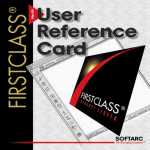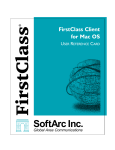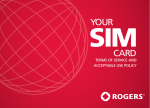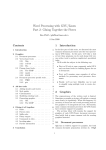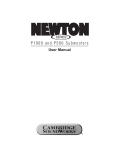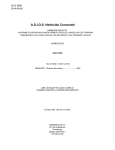Download FirstClass Client for Windows User Reference Card
Transcript
FirstClass Client for Windows USER REFERENCE CARD Connecting to FirstClass ® FirstClass® is an easy-to-use communication system for Windows. With FirstClass you can send and receive electronic mail, share files, use electronic conferencing to exchange ideas, and participate in on-line chats. Because FirstClass uses the familiar Windows graphical user interface, you will find it fast, intuitive, and easy to learn. FirstClass consists of two parts: the client (you) and a server. To use FirstClass, you will need both a Settings Document for the system that you want to connect to and the FirstClass Client application. You will also need to connect to the server using either a modem or a network. Before you can actually use FirstClass, you will need to log in, or connect, to the server. Splash Screen Starting FirstClass This contains information about the system that you are connect ing to. To start FirstClass, open the settings document for the system you want to connect to by double-clicking on the icon. You can also click once on its icon to select it, and then choose Open from the File menu. A typical settings document looks like this: User ID and Password You must have a User ID and password to connect to a First Class system. Contact your Administrator for details. On some systems you can also auto register and set up your own User ID. If you get tired of entering your User ID every time you log on, you can save it in the settings file by pressing the Setup button. The FirstClass client application looks like this: Starting FirstClass displays the Login Form for the system you’ve chosen. A typical Login Form is seen on the right. Setup Button Progress Display Login button As the connection is established, the progress is displayed in this area. If you have any problems logging in, contact your Administrator. To begin the login process, enter your User ID and your password, and click on the Login button. The Desktop Window Summary Press this button to change your settings. These settings include information on how to connect to the server and can include your User ID and Password. Once you’ve established the correct set tings you need, there should be no need to change them again. If you need help with these settings contact your Administrator. Once you have connected to the server, your FirstClass desktop appears on the screen. In the example below, the desktop has been customized with a background graphic. This is the starting point for using FirstClass. To open any item on the desktop, double-click on the appropriate icon. To close the desktop, either exit the FirstClass application or choose Disconnect from the Service menu. Unread Flag Your Mailbox An unread flag ( ) appears beside your mailbox or a conference if there are any items that you have not read. Note: You can turn the flag off by holding the Control key and clicking on the flag. This removes the flag from every message in the conference. Your mailbox contains all of the mail that you have received and sent. To open your mailbox (or any other item in FirstClass) double-click on the icon. News is a special conference used for general announcements. The window summary displays the name and type of the window as well as the number of files and folders in the window. News Conferences Folder Conference Aliases You can create aliases of conferences you are interested in by selecting the original and choosing Make Alias from the Confer ence menu. This puts a copy of the conference icon on your desktop for easy access. It also displays an unread flag when there are unread items. The conferences folder contains all of the public access conferences set up by your Administrator. Help Folder The help folder contains helpful instruc tions for using your FirstClass system. The File List Window The file list window appears when you open either a conference, a folder, or your mailbox. Generally, the files are shown with one line of information per item. To open an item in a file list, either double-click on it or select it and choose Open from the File menu. A message that you have opened is dimmed. For example, in the screen below, the second message has been selected and the third has been opened. You can also change the viewing mode to display either icons or a sorted list. The upper pane of the window contains folders, while the lower pane contains files. FirstClass also supports external folders that are links to CD-ROMs and hard disks. Fill Bar Number of Files Number of Folders Title The fill bar indicates that titles are still being added to the list. When the bar reaches the right edge of the window and disap pears, the list is complete. The total number of files in this list. The number of files displayed may be less if you’ve checked the Display Unread Only preference. The total number of fold ers and/or conferences in the list. Folders and con ferences always appear above the split bar. The title of the file list window is the name of the conference or folder. The name is also placed in the View menu. Maximize & Maximize Window Type Clicking on the maximize button at the right expands the window to show all of the items or as many as will fit on the screen. Clicking on the minimize button on the left shrinks the window back to its original size. The file list can be a confer ence, a mailbox, or a folder. Icon View This is an example of viewing by icon. To change to a sorted list, use the Window menu. Folders & Conferences The upper pane of any file list window can contain additional folders and conferences. Split Bar The split bar divides the window into two panes. The upper pane contains folders and conferences, the lower pane contains mes sages and files. To move the split bar, place the mouse over the bar and drag after the cursor changes to a cross, like this: Message Icon The standard message icon. A message received via a gate way has an icon like this: Attachment Icon All messages can have one or more files attached to them. If a message has attachments, the system adds an attachment icon to the summary. See the Attachments and File Transfer section for details. Scroll Bar The scroll bar functions like a typical Windows scroll bar. You can click in the grey area to move up or down by one screen. Unread Flag Sender Size Subject Date & Time Date View If you have not yet read an item, there will be an unread flag beside its icon. The name of the person who sent the message. Size of the message in kilobytes, including any attachments. The subject of the mes sage. This appears blank in an external folder. The time and date that the message was delivered. The lower pane is an example of viewing by date. To change the viewing style, use the View menu. Operations You will find that you spend most of your time in FirstClass working with file lists—either your mailbox, a conference, or an external folder. There are several operations that you can perform on a file list in addition to just opening the items in the list. These include: Creating New Messages Next & Previous Unread Delete To create a new message, choose New Message or New Form from the Message menu. If you are in a conference, the message is automatically addressed to the conference. A copy of any new messages you create is always placed in your mailbox. See the Addressing section for more information on addressing and sending messages. When you log on to FirstClass, you generally want to read your unread messages right away. You can quickly open unread items by choosing Open Unread from the Conference menu or by using the palette. If there are no more items with unread flags, the system notifies you with a beep. You can delete messages in your mailbox as well as any conference items that you have sent. Select the message and choose Delete from the File menu. You can select multiple items for deletion by shift-clicking. Note: If Delete is grayed out in the menu, then you cannot delete the selected item. Reply Next & Previous in Thread Replying to a message creates a new message with the To, Cc, and Subject lists filled in. Click in the lower pane and compose your message. When you reply to a message that was sent to you, the reply is automatically addressed to the person who sent it and to all the other recipients listed on the envelope. All replies within FirstClass become part of a thread which starts with the first message. The thread allows you to track all responses to the first message. When you have either opened or selected a message, choosing Next in Thread from the Conference menu opens the next message in the thread. You can also use the palette to move through the messages in a thread. Threading also works within your mailbox. Forward Folders & Dragging Forwarding a message creates a copy of the message (including any attachments). You can address and edit the message and add additional attachments. The message history displays a record of who has forwarded the message. Within your mailbox, you can create folders to file your messages. Choose New Folder from the Conference menu. To rename the folder or give it a custom icon, select it and choose Get Info from the File menu. You can now drag messages into the folder. History By choosing History from the Message menu, you can display the history of a message. This is a record of everything that has happened to the message, including when the message was composed, when it was sent and who has read it. If the message has any attachments, the history also indicates who has downloaded them. Make Alias If there is a particular conference you are interested in, you can place an alias of it on your desktop. Select the conference’s icon and choose Make Alias from the Conference menu. You can then reposition the alias on your desktop for maximum convenience. The Message Window When you open any message in a file list, the message appears in a Message Window. A message window also appears when you create a new message. After you have opened a new message, you can perform any action available from the file list or use the standard Windows editing commands. You can also use the threading feature to step through all messages in the thread. If you resize the window, subsequent messages appear in the resized window as you use the threading command. Message Icon Date Title Postmark The standard message icon. If the message has been sent via a gateway, it has a gateway message icon that looks like this: To use another icon, choose Get Info from the File menu and double-click on the icon in the info window. This is the date that the message was sent. If a message is unsent, this line will read “Unsent.” This is the subject of the message. After you send a message, the system places a postmark in the upper righthand corner. Envelope This is the envelope of the message. It contains addressing information, the list of attachments, the postmark, and the date and time the message was sent. If the message is a form, the envelope contains the additional form information—in this example, a picture preview. To view the entire picture, double-click on it. From The From name is always set to the name of the sender and cannot be changed. Subject Split Bar Enter the subject of the message here. If the message is a reply to another message, the subject is entered for you automatically and prefaced by Re. (Re: Graphics Animator 1.0, for example.) You can change this subject. The split bar divides the message win dow into two panes: the envelope and the message body. Each pane can be scrolled with its own scroll bar. Message Body To enter text in an unsent message, click in this area and start typing. Note: You can’t change text in the body of a sent message. Special forms Messages may be written on forms containing special fields or cus tomized graphics. Your system comes with several useful forms, including one for taking telephone messages and another for sending requisitions. To create a new mes sage with one of these forms, choose New Form from the message menu. Addressing Click in the To field, enter the name of the user or conference you want to send to, and press the Return key. You don’t have to worry about capital letters, and you don’t even have to enter the whole name, just enough to help in the search. Styled Text You can change the font, style, size, and color of text in the body by selecting the text and using the Edit menu. If you try to display a message which was com posed in a font that you do not have, the message appears in the system font. When you read a message, the To and Cc fields list the individuals and conferences to which the message was sent. When you create a new message, you fill in the To and Cc fields with the names of the people or conferences who are to receive the message. Here is an example: FirstClass searches its user directory for the closest match and places it back into the field. Résumés If the name matches more than one user, a window containing all matching names appears. Here the matches include all users and conferences which contain a name or a word beginning with the characters “roy.” Highlight the name you want and press the Select button. (You can select multiple names by shift-clicking.) The system places the selected name back into the envelope. Double-clicking on a name in a To, Cc, or From list; in a directory window; in a chat; or in a history window displays the résumé for that user. Each user and every conference has its own résumé. To edit your own résumé, chose Résumé from the Edit menu. The changes you make are saved when you close the résumé window. The top portion of the résumé form contains a field into which you can paste a picture of any size, and a title field into which you can enter your name. The bottom portion of the form is edited like a standard message. Palette and Session Status FirstClass has a floating palette that provides one-step access to common functions. To display the palette, choose Palette from the Window menu. There is also a floating session status window that appears when you choose Session Status from the Window menu. New Message Send The name of the FirstClass system that you are connected to. Forward Reply Attach File Display History Connected Time Find Find Next System Name The duration of the current session. Time Remaining The time you have remaining from your daily time limit. Warning: If you exceed your time limit you will have to wait until after midnight to log on again. Search Directory Delete Previous Unread Next Unread Previous In Thread Next In Thread Previous Message Next Message The Search feature allows you to search the entire FirstClass system for occurrences of specified words. To use the Search feature, open the folder or conference that you want to search and then choose Search from the File menu. A Search window appears. Enter the word you wish to search for in the Search for box and check the appropriate option boxes. Click on the Search button to start search ing every file in the current window. A new window opens and displays a list of any matching items. Double-click on an item in this list to open it. Selecting an item and choosing Get Info from the File menu displays exactly where the matching item was found. You can use the the Next Message and Pre vious Message buttons (on the palette) to move through the hit list, and the Find Next button to highlight the next occurrence of the word within a message. Check this box to search all subjects and file names for the word. Check this box to search the names of all attachments for the word. Check this box to search all the folders and conferences in the current window, as well as the files. Check this box to search the names in the From list for the word. Check this box to search the body of all messages and text files for the word. Check this box to search all of the names in the To and Cc lists for the word. Chat The Chat feature allows you to have real-time conversations with multiple users. To start a private chat, choose Private Chat from the Service menu. To enter a public chat, double-click on the chat’s icon. Input Box Enter your chat messages here. To send the message, press the Return key or press the Send button. Participants List A list of participants in chat. Doubleclick on a name for the user’s résumé. Chat Transcript The chat text appears here as the participants enter their messages. You will also receive notification when people enter and leave the chat. Choose Save as Text from the File menu to save a copy of the transcript. Sounds Check this box to hear sounds when new chat messages are delivered and when a user enters or leaves the chat. Invite Button To invite other users into the chat, click on the Invite button. Select the names of the users you wish to invite and press the Select button. Attachments and File Transfer FirstClass allows you to transfer or share files with other users using the attach ment feature. When you compose a message, you can attach any file stored in your computer to the message. You then send the message as usual. When you read a message with attachments, you can transfer any of the attachments to your computer. A powerful feature of FirstClass is that attachments work well with both private mail and conferences. This means that you can easily distribute files to large numbers of users. Downloading If a message has any files attached, the attachments are listed in the envelope after the To and Cc lists. To transfer, or download, an attachment from the FirstClass server to your computer, select the attachment and then choose Save Attachment from the File menu (or just double-click on it). This brings up a dialog box that allows you select where on your computer you want the file saved. Once you have selected the location, click on the OK button. The system transfers the file from the FirstClass server to your computer. Note: The time required for the transfer varies depending on the size of the file and the speed of your connection. As the system transfers the file, the File Transfer Progress window appears. You can continue to use all of the features of FirstClass even while a file transfer is in progress. To cancel a transfer, close the progress window. If you cancel a file transfer before it is finished, you can restart the transfer by downloading to the same location on your computer. When prompted “Replace existing file?” click on the “Yes” button. Only the remaining data will be transferred. If the attachment is a picture or a text file, you can view itonline by selecting it, holding down the Control key, and choosing Save Attachment from the File menu (or just holding down the Control key and double-clicking on it). The attachment appears in a new window. To save a text attachment, choose Save as Text from the File menu. Uploading To send a file to another user or a conference, compose a new message as usual. To add an attachment to the unsent message, choose Attach File from the File menu. You will be prompted to select the file that you want to attach. Select the file you want to attach and then click the OK button to transfer, or upload, the file from your computer to the server. The time required for the transfer will vary depending on the size of the file and the speed of your connection. While the file is being transferred, the File Transfer Progress window is displayed. You can continue to use all of the features of FirstClass even while the file transfer is in progress. When the transfer completes, the attachment will be listed in the envelope of the message. You can attach as many files as you wish. If you make a mistake, you can delete an attachment by selecting it and then pressing the Delete key. If you are sending attachments that will be downloaded by users logged on with modems, or if you are using a modem, you should consider using a compression utility. Compressing files allow them to be sent faster, thereby reducing the duration of your phone calls. They also use up less storage space on the server. If a file is only partially uploaded, it will have a partial transfer icon ( ). To continue from the point the transfer stopped, restart the transfer. When prompted “Replace existing file?” click on the “Yes” button. Only the remaining data will be transferred. This document copyright © 1996 SoftArc Inc. 100 Allstate Parkway, Markham, Ontario, Canada L3R 6H3 Phone 905-415-7000 Fax 905-415-7151 SoftArc Online 905-415-7070. This document can be reproduced in part or in whole by any registered owner of the FirstClass product from SoftArc providing this copyright mark is left intact. A complete user manual is also available. FirstClass and the FirstClass Logo are registered trademarks of SoftArc Inc. Windows is a registered trademark of Microsoft Corporation. Other products mentioned in this document may be trademarks or registered trademarks of their respective companies and are hereby acknowledged.







